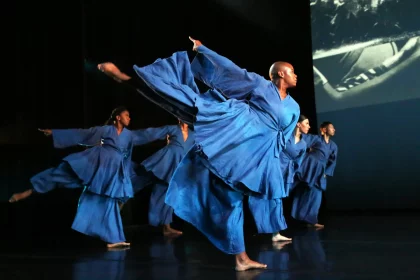
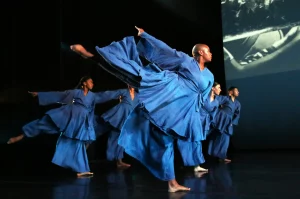
We had all witnessed EVIDENCE
Sixteen of us then made it across the street to the Chinese restaurant on the eve of the year of the water rabbit, 4720, in China, 14 time zones ahead of us. According to the official Chinese state news agency Xinhua, tradition notes the rabbit as the luckiest of the 12 zodiac animals, representing peace and longevity. Kimmy Yam claims it also as evocative of the power of empathy. In Vietnam, the same day marks the eve of the year of the cat, a totem characterized as tranquil, realistic, intelligent, and artistic. All seven of these qualities had just been on display across 8th Avenue on the stage of the Joyce Theater, clearly visible through the front windows of the eatery that had stayed open late just for us.
We got to work helping Nina, our hostess, rearrange tables into a large irregular square in order to accommodate everyone in the group at a single platform within easy enough speaking distance from one another. This marked the first collaborative action that a Dancing Matters crew undertook as a community. As an omen of renewal and resilience that seemed to echo what we had just taken in, a concert consisting of three works by Ronald K. Brown crowned with an onstage appearance by the creator alongside Associate Artistic Director Arcell Cabuag at the final curtain bow, the physical nature of our initial communal activity augured well no matter which calendar you may consult.
Dancing Matters aims to create, foster, and promote democratic and collaborative critical response from across the wide and inclusive spectrum of dance related communities that the Dance Parade and DanceFest manifests each May. The group at the square table included several current and former professional dancers and choreographers, practitioners of the 5Rhythms meditative movement practice founded by the late Gabrielle Roth, at least one professional DJ, one creative writer with a movement background and others whose relationship to dancing might be characterized more ineffably. We went around the table person by person, each offering a few words that they might share with one another or a loved one as a way of conjuring and encapsulating an overall reaction to what they had just experienced.
Our professional DJ proved the first to comment on the formidable contributions of Brown’s collaborators in music and costuming. The curtain had parted on “Open Door” to begin the show revealing Andrew Antron seated at the baby grand piano audience left with the rest of Arturo O’Farrill’s band Resist made up of seven other members of the Afro Latin Jazz Orchestra in a line across the rear of the stage back lit at the cyclorama and largely in silhouette. The choreography, originally commissioned and performed by the Alvin Ailey American Dance Theatre in 2015, received its company premiere with these performances at the Joyce and the live presence of this fine ensemble along with their crisp Afro Cuban polyrhythmic sound served as a foretaste of the exquisite production values that would apply across the evening.
Our DJ did not neglect the music of Jason Moran accompanying the middle offering “The Equality of Night and Day,” which received its New York City premiere with these Joyce presentations. Nor did she ignore the Duke Ellington, Roy Davis, Jr., and Fela Anikulapo Kuti suite for the perennial favorite and crowd-pleasing finale “Grace,” commissioned, like “Open Door,” for the Ailey troupe (1999) and re-configured for EVIDENCE in 2003. Each recorded score sparked a similarly strong dialogue with the dancing and other stage elements.
Arcell Cabuag receives acknowledgement as Associate Choreographer for “Open Door.” Keiko Voltaire designed the costumes for this opus matching the imaginative flow if not the striking color of Omotayo Wunmi Olaiya’s designs for the other two works. Except for the projected photo collages curated by Deb Willis for “The Equality…”, no one at the table mentioned the superb set and lighting design and technical direction from Tsubasa Kamei that sustained throughout the evening, nor the accompanying text heard in recordings of the political activist and academic Angela Y. Davis. My oversight, I fear.
I have known and admired Ron Brown and his work, sometimes close at hand, since he, Dean Moss and I each presented duets as choreographer/performers decades ago on a single program of the Fresh Tracks platform at Dance Theater Workshop (DTW), which has since morphed into New York Live Arts. Yet this concert offered my first opportunity to ingest at one sitting such a panoply of his enormous creative output across the years of a generation and consider the significance of his contribution to the field not only in terms of his work over time but of his mentorship and development of a legion of strong voices among the dancers who have risen in his company such as Camille A. Brown, to point out just one.
It seemed to me that the mastermind of this home season within the warm and friendly confines of the Joyce engaged an interrogation in each of these three pieces, not only regarding individuality, community, and social justice as manifest in the movement of his company and the contributions of his collaborators, but among the technical discipline, tempos, rhythm and compositional elements that make dancing speak, especially as it draws from within bodies coming from across the African diaspora and beyond.
Besides the work of both Alvin Ailey and Camille A. Brown, between whom he represents a creative bridge, the choreography also recalled for me that of Garth Fagan in both its compositional invention and arresting deployment of stillness. I will leave it to other members of Dancing Matters to supplement as they wish.
Dancers in the Ronald K. Brown/Evidence company in “The Equality of Night and Day” at the Joyce Theater in New York.Credit…Andrea Mohin/The New York Times
Review: A Dance Searching for Harmony in an Unequal World
By Gia Kurlas
Jan. 18, 2023
“The Equality of Night and Day,” a New York premiere by the choreographer Ronald K. Brown and his company, Evidence, essentially starts out mid thought. A voice says, “And finally.”
It’s so no-nonsense that it practically sounds like a complete sentence. Spoken by the activist Angela Davis in a tone verging on weariness, the “and finally” urges the crowd — at least the one you imagine standing before her — to think about the larger picture, as she talks about issues that ail the United States, like “the assault against affirmative action” and “the increasing conservatism.”
The dancer Joyce Edwards, a silky powerhouse full of drama whether seemingly motionless or rippling her body with fervor, is poised center stage: She bends forward and rises back up with crossed wrists until her arms lift and bloom out like glorious wings. The lighting evokes the faded radiance of a sunset. As the other dancers gather around her, she clasps her hands, and we hear Davis ask that the people before her “think very deeply about what you can do to make a difference.”
Davis’s speeches are heard throughout this 2022 work, performed at the Joyce Theater, but better is its sparkling score by the jazz pianist Jason Moran. The music starts out spare and contained, but gradually builds with blistering, tinkering speed to get at, sonically, the urgency of not just one, but multiple generations that have faced oppression.


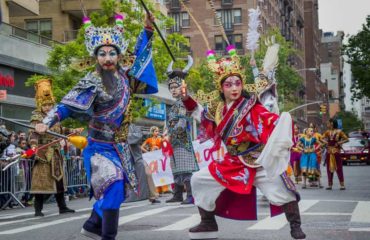
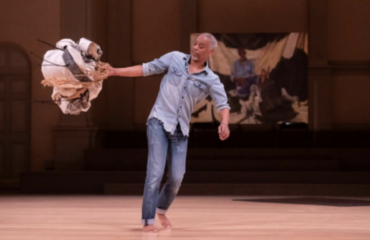
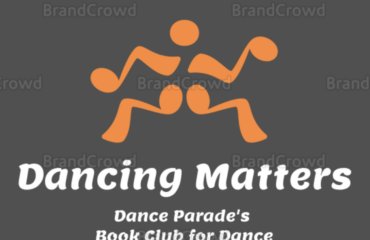
You must be logged in to post a comment.